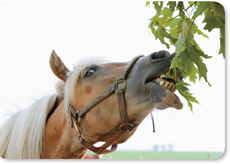▸ Eating Meat  Carnivores typically have sharp mouthparts or other structures that can capture food, hold it, and “slice and dice” it into small pieces. Carnivorous mammals, such as wolves, have sharp teeth that grab, tear, and slice food like knives and scissors would. The jaw bones and muscles of carnivores are adapted for up and down movements that chop meat into small pieces.
Carnivores typically have sharp mouthparts or other structures that can capture food, hold it, and “slice and dice” it into small pieces. Carnivorous mammals, such as wolves, have sharp teeth that grab, tear, and slice food like knives and scissors would. The jaw bones and muscles of carnivores are adapted for up and down movements that chop meat into small pieces.
▸ Eating Plant Leaves  Herbivores typically have mouthparts adapted to rasping or grinding. To digest leaf tissues, herbivores usually need to tear plant cell walls and expose their contents. To do this, many herbivorous invertebrates, from mollusks to insects, have mouthparts that grind and pulverize leaf tissues. Herbivorous mammals, such as the horse in Figure 27–4, have front teeth and muscular lips adapted to grabbing and pulling leaves, and flattened molars that grind leaves to a pulp. The jaw bones and muscles of mammalian herbivores are also adapted for side-to-side “grinding” movements.
Herbivores typically have mouthparts adapted to rasping or grinding. To digest leaf tissues, herbivores usually need to tear plant cell walls and expose their contents. To do this, many herbivorous invertebrates, from mollusks to insects, have mouthparts that grind and pulverize leaf tissues. Herbivorous mammals, such as the horse in Figure 27–4, have front teeth and muscular lips adapted to grabbing and pulling leaves, and flattened molars that grind leaves to a pulp. The jaw bones and muscles of mammalian herbivores are also adapted for side-to-side “grinding” movements.
Specialized Digestive Tracts Carnivorous invertebrates and vertebrates typically have short digestive tracts that produce fast-acting, meat-digesting enzymes. These enzymes can digest most cell types found in animal tissues.
No animal produces digestive enzymes that can break down the cellulose in plant tissue, however. Some herbivores have very long intestines or specialized pouches in their digestive tracts that harbor microbial symbionts that digest cellulose. Cattle, for example, have a pouchlike extension of their esophagus called a rumen (plural: rumina), in which symbiotic bacteria digest cellulose. Animals with rumina, or ruminants, regurgitate food that has been partially digested in the rumen, chew it again, and reswallow it. This process is called “chewing the cud.”

FIGURE 27–4 Eating Plant Leaves The teeth and jaws of herbivores, such as horses, are adapted for pulling, rasping, and grinding plant leaves.
27.1 Assessment

-
Review What types of food do herbivores eat? What are nutritional symbionts?
Relate Cause and Effect How might a coral be affected if all its symbiotic algae died?
-
Review What are two types of digestion animals use to break down and absorb food?
Compare and Contrast What is a major structural difference between gastrovascular cavities and digestive tracts?
-
Review Describe the adaptations of the mouthparts and digestive systems of leaf-eaters and meat-eaters.
Use Analogies Describe the relationship between a ruminant and its microbial symbionts in terms of “teamwork.”
WRITE ABOUT SCIENCE
Describe the process of a cow's digestion of grass, from the cow's uprooting of the grass to its reswallowing of it. Use the terms molar, rumen, symbiont, and cud.

Table of Contents
- Formulas and Equations
- Applying Formulas and Equations
- Mean, Median, and Mode
- Estimation
- Using Measurements in Calculations
- Effects of Measurement Errors
- Accuracy
- Precision
- Comparing Accuracy and Precision
- Significant Figures
- Calculating With Significant Figures
- Scientific Notation
- Calculating With Scientific Notation
- Dimensional Analysis
- Applying Dimensional Analysis




